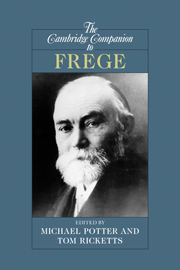Book contents
- Frontmatter
- 1 Introduction
- 2 Understanding Frege’s project
- 3 Frege’s conception of logic
- 4 Dummett’s Frege
- 5 What is a predicate?
- 6 Concepts, objects and the Context Principle
- 7 Sense and reference: the origins and development of the distinction
- 8 On sense and reference: a critical reception
- 9 Frege and semantics
- 10 Frege’s mathematical setting
- 11 Frege and Hilbert
- 12 Frege’s folly: bearerless names and Basic Law V
- 13 Frege and Russell
- 14 Inheriting from Frege: the work of reception, as Wittgenstein did it
- Bibliography
- Index
- Series List
2 - Understanding Frege’s project
Published online by Cambridge University Press: 28 September 2010
- Frontmatter
- 1 Introduction
- 2 Understanding Frege’s project
- 3 Frege’s conception of logic
- 4 Dummett’s Frege
- 5 What is a predicate?
- 6 Concepts, objects and the Context Principle
- 7 Sense and reference: the origins and development of the distinction
- 8 On sense and reference: a critical reception
- 9 Frege and semantics
- 10 Frege’s mathematical setting
- 11 Frege and Hilbert
- 12 Frege’s folly: bearerless names and Basic Law V
- 13 Frege and Russell
- 14 Inheriting from Frege: the work of reception, as Wittgenstein did it
- Bibliography
- Index
- Series List
Summary
Frege begins Die Grundlagen der Arithmetik, the work that introduces the project which was to occupy him for most of his professional career, with the question, 'What is the number one?' It is a question to which even mathematicians, he says, have no satisfactory answer. And given this scandalous situation, he adds, there is small hope that we shall be able to say what number is. Frege intends to rectify the situation by providing definitions of the number one and the concept of number. But what, exactly, is required of a definition? Surely it will not do to stipulate that the number one is Julius Caesar - that would change the subject. It seems reasonable to suppose that an acceptable definition must be a true statement containing a description that picks out the object to which the numeral '1' already refers. And, similarly, that an acceptable definition of the concept of number must contain a description that picks out precisely those objects that are numbers - those objects to which our numerals refer. Yet, while Frege writes a great deal about what criteria his definitions must satisfy, the above criteria are not among those he mentions. Nor does he attempt to convince us that his definitions of '1' and the other numerals are correct by arguing that these definitions pick out objects to which these numerals have always referred.
Yet, while Frege writes a great deal about what criteria his definitions must satisfy, the above criteria are not among those he mentions. Nor does he attempt to convince us that his definitions of ‘1’ and the other numerals are correct by arguing that these definitions pick out objects to which these numerals have always referred. There is, as we shall see shortly, a great deal of evidence that Frege’s definitions are not intended to pick out objects to which our numerals already refer. But if this is so, how can these definitions teach us anything about our science of arithmetic? And what criteria must these definitions satisfy? To answer these questions, we need to understand what it is that Frege thinks we need to learn about the science of arithmetic.
- Type
- Chapter
- Information
- The Cambridge Companion to Frege , pp. 32 - 62Publisher: Cambridge University PressPrint publication year: 2010
- 21
- Cited by

